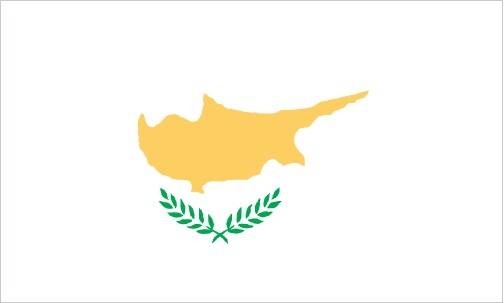138 Cyprus

Centered on a white field is a copper-colored silhouette of the island (the island has long been famous for its copper deposits) above two olive-green-colored, crossed olive branches. The branches symbolize the hope for peace and reconciliation between the Greek and Turkish communities.
Flag courtesy of the CIA World Factbook

Map courtesy of the CIA World Factbook

The ruins of the Roman gymnasium at Salamis, on the east coast of Cyprus.
Photo courtesy of the CIA World Factbook
Government
According to Britannica, the constitution of the Republic of Cyprus, adopted in 1960, provided that executive power be exercised by a Greek Cypriot president and a Turkish Cypriot vice president, elected to five-year terms by universal suffrage, and that there be a Council of Ministers (cabinet) comprising seven Greek Cypriot and three Turkish Cypriot members. It also called for an elected House of Representatives with 50 seats, divided between Greek and Turkish Cypriots in the proportion of 35 to 15 and elected for terms of five years.
The constitution, derived from the negotiations in Zürich, Switzerland, in 1959 between representatives of the governments of Greece and Turkey, was not widely accepted by the citizens of the new republic. The Greek Cypriots, whose struggle against the British had been for enosis (union with Greece) and not for independence, regretted the failure to achieve this national aspiration. As a result, it was not long after the establishment of the republic that the Greek Cypriot majority began to regard many of the provisions, particularly those relating to finance and to local government, as unworkable. Proposals for amendments were rejected by the Turkish government, and, after the outbreak of fighting between the two Cypriot communities in late 1963, the constitution was suspended. In the Republic of Cyprus after the Turkish occupation of 1974, the constitution’s provisions remained in force where practicable; the main formal change has been the increase in the number of seats in the House of Representatives to 80, although the 24 seats allocated to Turks have remained vacant.
On the Turkish side of the demarcation line, there have been, since 1974, a popularly elected president, prime minister, and legislative assembly, all serving five-year terms of office. A new constitution was approved for the Turkish Republic of Northern Cyprus (TRNC) by its electorate in 1985.
Local government in the Republic of Cyprus is at the district, municipal, rural municipality, and village levels. District officers are appointed by the government; local councils are elected, as are the mayors of municipalities.
The legal code of Cyprus is based on Roman law. In the Greek Cypriot zone judges are appointed by the government, but the judiciary is entirely independent of the executive power. The Supreme Court is the highest court and also serves as the final appeals court in the republic. A Permanent Assize Court has criminal jurisdiction over the whole island, and district courts handle criminal, civil, and admiralty matters. The Turkish Cypriot zone has a similar system of justice.
Department of Civil Aviation
Cyprus became a member of the ICAO, an agency of the United Nations, shortly after its independence in February 1961.
ICAO has entrusted and delegated to the Department of Civil Aviation the responsibility to provide air traffic control services in a space of an area covering 175,000 square kilometers, which is several times the size of Cyprus.
Airspace
SkyVector – Google Maps – ADS-B Exchange
ICAO countries publish an Aeronautical Information Publication (AIP). This document is divided into three parts: General (GEN), En Route (ENR) and Aerodromes (AD). ENR 1.4 details the types of airspace classes they chose to adopt from classes A through G.
Drone Regulations
Advanced Air Mobility (AAM) Regulations & Policies
Bilateral agreements facilitate the reciprocal airworthiness certification of civil aeronautical products imported/exported between two signatory countries. A Bilateral Airworthiness Agreement (BAA) or Bilateral Aviation Safety Agreement (BASA) with Implementation Procedures for Airworthiness (IPA) provides for airworthiness technical cooperation between the FAA and its counterpart civil aviation authorities.
Reciprocal acceptance of aviation safety-related approvals and services with the European Union Aviation Safety Agency (EASA) and Member States of the European Union are primarily governed by the U.S. – European Union Safety Agreement.
Advanced Air Mobility (AAM) News
None found by the author.
However, should you, the reader, happen to stumble across something to the contrary, please email the author at FISHE5CA@erau.edu and you may be mentioned in the ACKNOWLEDGEMENTS section of this book by way of thanks for contributing to this free eBook!
Short Essay Questions
Scenario-Based Question
You have been hired by a Drone Startup Company. Your boss has immediately assigned this job to you.
They need you to prepare a one-page memo detailing the legalities of using a drone to film the ruins, pictured above.
They need you to mention any national laws and local ordinances.
They specifically want to know what airspace (insert pictures) you will be operating in and whether or not you need an airspace authorization.
Does it matter whether or not you are a citizen of the country?
Lastly, there is a bonus for you if, as you scroll through this chapter, you find any typos or broken links!
Short Essay Questions
- What are the drone categories?
- How is registration addressed?
- How is remote ID addressed?
- What are the model aircraft rules?
- What are the commercial drone rules?
- Are there waivers or exemptions to the rules? If so, for what?
- Would you share a link to an interactive airspace map?
- How is BVLOS addressed?
- How can you fly drones at night?
- How can you fly drones over people?
- Where do you find drone NOTAMs?
- What are the rules for drone maintenance?
- What are the rules for an SMS program?
- What are some unique rules not mentioned above?
- What are the C-UAS rules?
- What are the AAM rules?

